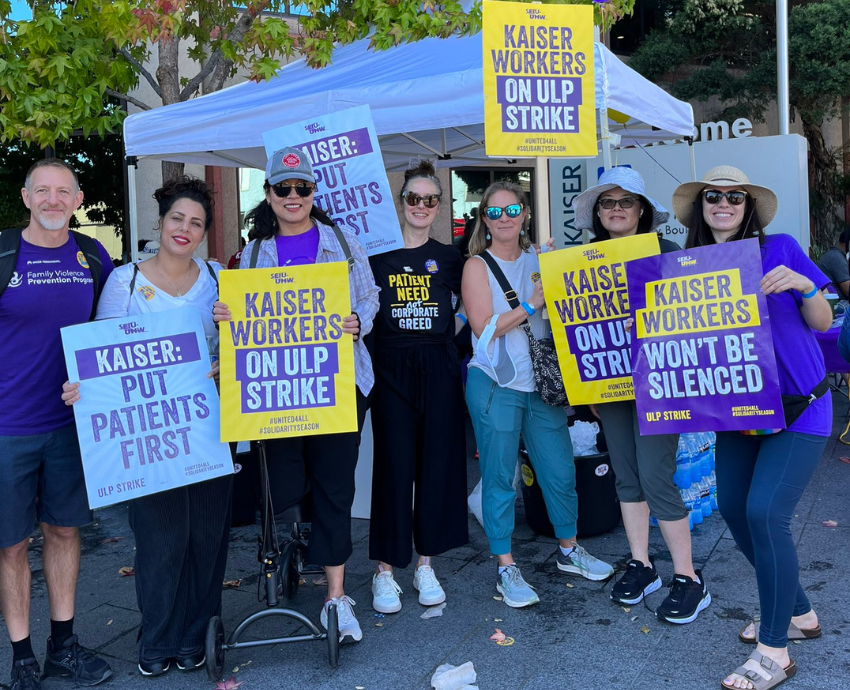
Healthcare workers in the United States won a tentative agreement with industry giant, Kaiser Permanente on October 13, for a 21% pay rise over four years and other improvements following their historic three-day strike.
Tens of thousands of workers took strike action across the country from October 4‒6 in pursuit of a collective agreement. Many patients able to do so joined picket lines.
Kaiser employs more than 300,000 healthcare workers across the country.
Striking workers included nurses, nurses’ aides and optometry and pharmacy technicians. Kaiser is severely understaffed and one of the unions’ demands was for 10,000 new hires.
Registered Nurses and Nurse Practitioners settled their new four-year contract with Kaiser in December.
The largest union involved in the strike was the Service Employees International Union - United Healthcare Workers West (SEIU-UHW West), representing 85,000 members.
SEIU-UHW West president Dave Regan told picketing workers that the strike was about unfair labour practices and Kaiser’s refusal to meet the union’s just demands.
Pickets
Pickets at Kaiser-Santa Rosa, in Sonoma County, in northern California’s “Wine Country”, where I live, came out strong. Many strikers said the number one issue was pay and staff shortages.
It is common that Kaiser uses short-term workers from other hospitals — including from outside the state — to fill short-term positions. Many of these workers are seeking full-time jobs.
Jeannie Gerbich, an ultrasound technician who has worked for KP for 13 years, told picketing workers: “We can’t give our patients and customers service unless we are staffed properly.”
Another worker told Press Democrat that Kaiser’s wages have not kept up the cost of living and staff reductions on her team mean more patients for those who are left.
“We used to have eight patients, now we have 12,” she said.
One lab technician told me: “They want full time positions, but Kaiser refuses to hire them.”
Last year, in a survey of 33,000 Kaiser employees, two-thirds of respondents said they had seen patient care delayed or denied due to short staffing during the COVID-19 pandemic.
As a longtime Kaiser member, I’ve seen first-hand the staff shortages, as appointments take longer and longer to get — even for critical care. Simple routine appointments can take weeks or even months.
The Union Coalition led by the SEIU-UHW, were prepared to expand their strike, if negotiations on October 12‒13 had failed. However, a deal was reached at the 11th hour and with the involvement of acting US Labor Secretary, Julie Su.
Union members began voting on the deal on October 18 and according to union sources, the ballot result will be declared on November 3.
Key demands
Workers sought protections against subcontracting and outsourcing, better performance-sharing bonuses, an improved retiree medical plan, and unionisation rights for employees of non-union entities acquired by Kaiser.
The unions called for a new wage package to keep up with the cost of living, including: a US$25/hour minimum wage for all Kaiser positions; investment in the education and training of future healthcare workers; and for Kaiser to work with the unions to defend and expand access to quality, affordable healthcare.
According to npr.org, the tentative agreement means workers in California will get a US$25/hour minimum wage, with $23/hour for workers in other states.
Before the final deal was struck, Kaiser bosses were only offering 12.5‒16% over four years, a $23/hr minimum wage in California starting in 2024 and $21/hr in other states.
While Kaiser is registered as a non-profit company and is not publicly traded on the Stock Exchange, it operates like all other for-profit hospital chains and pays its executives millions of dollars in salaries and bonuses.
According to the union coalition, “Kaiser’s CEO was compensated more than $16 million in 2021, and 49 executives at Kaiser are compensated more than $1 million annually.”
Before the strike began, the union coalition also revealed that Kaiser reported $3 billion in profits in the first six months of this year. It “pays no income taxes on its earnings” as a “non-profit” and “reported more than $24 billion in profit over the last five years”.
Union members said understaffing has boosted the hospital system’s profits but is hurting patients. There is no recognition of the workers once called “essential” during the COVID-19 pandemic.
The Kaiser workers’ win comes amid a surge in union organising and action, including the United Auto Workers strike and the Hollywood writers and actors’ strikes.
There have been several strikes in the healthcare industry, as workers seek to address staffing shortages, burnout and heavy workloads.
According to NPR, “[o]ther details of the agreement include new restrictions on hiring subcontractors and using outside firms for temporary staffing.
“The deal also requires Kaiser to invest in job training programs, and use referral bonuses, mass job fairs and other workforce development efforts to ensure an adequate supply of new employees for the future.
“Kaiser says it will also work to fill some of its vacant positions, one of the main components of the [union] coalition's demands. Currently, 11% of positions are unfilled.”
Following the conclusion of negotiations, Regan said: "We think we have the ability to create 25,000 new health care workers over the next four years."